Chess: Understanding the Sicilian Defense (Najdorf Variation) Part I
1 e4 c5 2 Nf3 d6 3 d4 cxd4 4 Nxd4 Nf6 5 Nc3 a6
6 Bg5 e6 7 f4 Be7 8 Qf3 Qc7 9 O-O-O Line
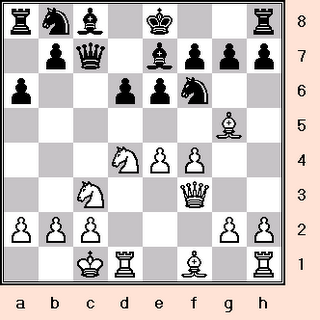
Also available:
Chess: Understanding the Sicilian Najdorf Part II
http://chesscoach1950.blogspot.com/2006/07/chess-understanding-sicili_115316520058364198.html
Chess: Understanding the Sicilian Najdorf Part III
http://chesscoach1950.blogspot.com/2006/07/chess-understanding-sicilian-najdorf.html
Chess: Understanding the Sicilian Najdorf Part IV
http://chesscoach1950.blogspot.com/2006/07/chess-understanding-sicilian-najdorf_17.html
Chess: Understanding the Sicilian Najdorf Part V
http://chesscoach1950.blogspot.com/2006/07/chess-understanding-sicilian-defense_23.html
Chess: Understanding the Sicilian Najdorf Part VI
http://chesscoach1950.blogspot.com/2007/01/chess-understanding-sicilian-defense.html
Chess: Understanding the Sicilian Defense
(Accelerated Fianchetto)
http://chesscoach1950.blogspot.com/2006/07/chess-understanding-sicilian-defense.html
Chess: Understanding the Sicilian Defense
(Keres Attack) Part I
http://chesscoach1950.blogspot.com/2006/06/chess-understanding-sicilian.html
Chess: Understanding the Smith Morra Gambit
http://chesscoach1950.blogspot.com/2006/06/chess-understanding-smith-morra-gambit.html
Chess: Understanding the Sicilian Richter
http://chesscoach1950.blogspot.com/2006/06/chess-understanding-sicilian-richter.html
Chess: Understanding the Sicilian Defense
(Sveshnikov Variation)
http://chesscoach1950.blogspot.com/2006/06/chess-understanding-sicilian-defense.html
Chess: Understanding the Sicilian Defense
(Sozin Variation)
http://chesscoach1950.blogspot.com/2006/01/chess-understanding-sicilian-defense_30.html
Chess: Understanding the Sicilian Dragon
http://chesscoach1950.blogspot.com/2006/01/chess-understanding-sicilian-dragon.html
Chess: Understanding the Sicilian Defense
(Löwenthal Variation)
http://chesscoach1950.blogspot.com/2006/08/chess-understanding-sicilian-defense_23.html
Chess: Understanding the Sicilian Defense
http://chesscoach1950.blogspot.com/2006/08/chess-understanding-sicilian-defense_22.html
1 e4

Controlling the central square d5 plus near-central
square f5, and, opening up a diagonal for both the
Queen and f1 bishop.
1 ... c5
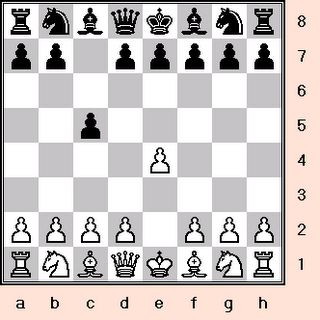
The d4 and b4 squares are now under Black's influence,
and his Queen also gets breathing space along the a5-d8
diagonal.
2 Nf3
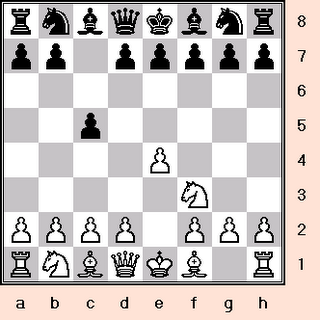
White prepares for d4 so as to challenge Black's hold
on that key square.
2 ... d6
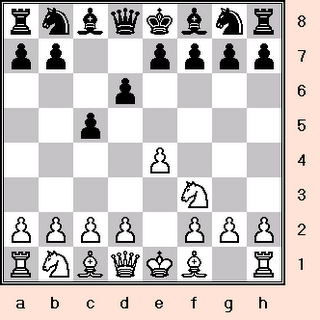
Shielding e5 from a prospective e4-e5 advance.
Please remember, the acquisition of e5 is a
critical theme for the defense. This move also
opens up a diagonal for the c8 bishop.
3 d4
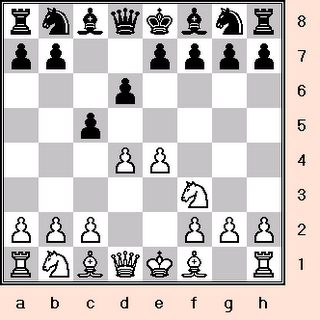
3 ... cxd4
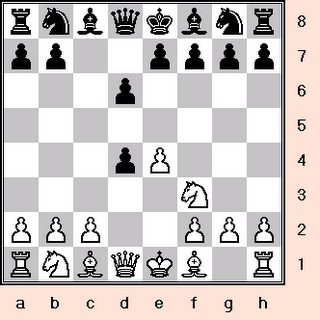
By trading his c-pawn for White's d-pawn,
Black guarantees pressure down the half
open c-file and chances to mold his
central pawn majority into a strong
center.
4 Nxd4

In return, White gains a developmental lead,
the half open d-file and an edge in space.
4 ... Nf6
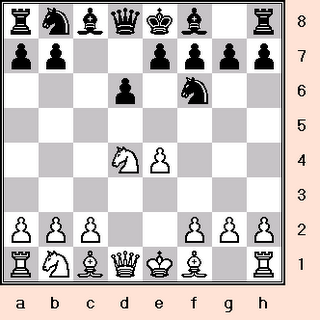
The e4 pawn now needs protection, and so White
responds with:
5 Nc3
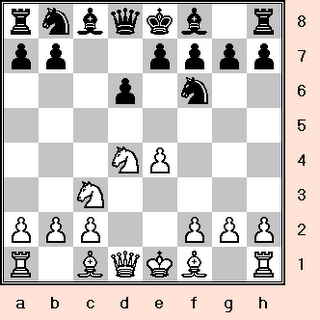
5 ... a6

Initiating the Najdorf Defense.
Black achieves two goals with this move:
(i) He deters White's pieces from intruding
on the b5 square.
(ii) He prepares for the ... b5 break, which,
in turn, initiates queenside action and
makes room on b7 for the c8 bishop.
6 Bg5
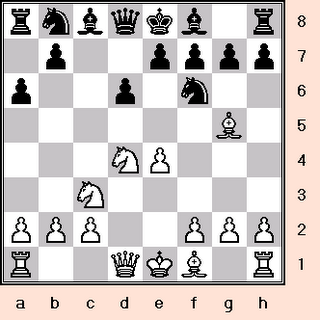
Threatening 7 Bxf6. The idea is to:
(i) Eliminate the knight's d5 influence in
order to attain a firmer grip on that focal
point.
(ii) Compromise Black's pawn structure
(7 Bxf6 gxf6/exf6).
6 ... e6
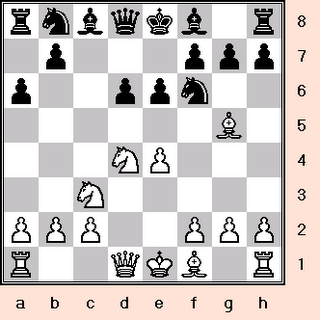
White's control of d5 and f5 is challenged and the
e7 square is vacated for the f8 bishop.
6 ... Nbd7 7 Bc4 Qa5 8 Qd2 e6 9 O-O-O b5 10 Bb3 Bb7
11 Rhe1 O-O-O 12 a3 Kb8 13 f4 Rc8 14 e5 dxe5 15 fxe5
15 ... b4 16 Na2 Ne4 17 axb4 Qxe5 18 Qf4 Qxf4+ 19 Bxf4+
19 ... e5 20 Nf5 exf4 21 Rxd7.
6 ... Qb6? 7 Bxf6 gxf6 8 Nd5 Qa5+ 9 Qd2 Qxd2+ 10 Kxd2,
and White looks better. The same is true after:
6 ... e5? 7 Nf5 Bxf5 8 exf5 Nbd7 9 Bc4 Rc8 10 Bb3 Be7
11 0-0 0-0 12 Bxf6 Nxf6 13 Qf3 b5 14 Rfd1.
6 ... e5? 7 Nf5 Bxf5 8 exf5 Nbd7 9 Bc4 Rc8 10 Bb3 Be7
11 0-0 0-0 12 Bxf6 Nxf6 13 Qf3 d5 14 Nxd5 e4
15 Nxf6+ Bxf6 16 Qxe4 Bxb2.
6 ... e5? 7 Nf5 Bxf5 8 exf5 Nbd7 9 Bc4 Rc8 10 Bb3 Be7
11 0-0 0-0 12 Bxf6 Nxf6 13 Qf3 d5 14 Nxd5 Nxd5
15 Rad1 e4 16 Qxe4 Nf6 17 Rxd8 Nxe4 18 Rxc8 Rxc8
19 Re1 Rd8 20 g3.
7 f4

Preparing for an eventual e4-e5 pawn push,
protecting the bishop on g5 and facilitating
the Queen's development to f3. Once there,
she can step sideways to g3 to aid e4-e5.
7 ... Be7
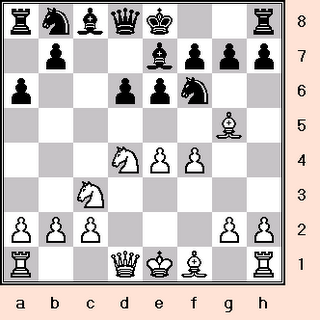
Breaking the pin on the f6 knight.
7 ... Qb6 inaugurates the Poisoned Pawn Variation:
8 Qd2 Qxb2 9 Rb1 Qa3 10 f5 Nc6 11 fxe6 fxe6 12 Nxc6
12 ... bxc6 13 e5 dxe5 14 Bxf6 gxf6 15 Be2.
7 ... Qb6 8 Nb3 Be7 9 Qf3 Nbd7 10 O-O-O Qc7 11 Bd3 b5
12 a3 Bb7 13 Rhe1 O-O-O 14 Qe2 h6 15 Bh4 g5 16 Bg3 gxf4
17 Bxf4 Ne5 18 Kb1.
7 ... b5 8 e5 dxe5 9 fxe5 Qc7 10 exf6 Qe5+ 11 Be2 Qxg5
12 Qd3 Qxf6 13 O-O-O Be7 14 Rhf1 Qh6+ 15 Kb1 O-O 16 Qg3
16 ... Qg5.
7 ... b5 8 e5 dxe5 9 fxe5 Qc7 10 exf6 Qe5+ 11 Be2 Qxg5
12 Qd3 Qxf6 13 Rf1 Qe5 14 O-O-O Ra7 15 Ndxb5 Qg5+
16 Rd2 Rd7.
8 Qf3

8 ... Qc7

From c7, the Queen dissuades White from
advancing 9 e4-e5 because of 9 ... dxe5 10 fxe5
10 ... Qxe5+. Additionally, she gets to mind
the half open c-file. Please observe how the
Queen cannot be harassed by Ndb5 because
of 5 ... a6.
Another popular option is 8 ... h6 9 Bh4 Qc7 10 0-0-0 Nbd7
11 Bd3 g5 12 fxg5 Ne5 13 Qe2 Nfg4 14 Nf3 hxg5 15 Bg3 Nxf3
16 gxf3 Ne5 17 Qf2 Bd7 18 h4 gxh4 19 Bxh4 Qc5 20 Qxc5 dxc5
21 Bxe7 Nxd3+ 22 cxd3 Kxe7.
9 0-0-0

Assigning the King to safety and developing the a1 rook
to the half open d-file.
9 ... Nbd7
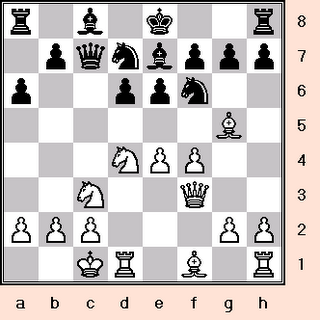
Development towards the ever so important e5 square.
Also, the knight gains access to c5.
9 ... Nc6 10 Nxc6 bxc6 11 e5 dxe5 12 fxe5 Nd5
13 Bxe7 Nxe7 14 Ne4 0-0 15 Qc3 Nd5 16 Qd4 Rb8
17 c4 c5 18 Nxc5 Nb4.
9 ... h6 10 Bh4 Nxe4 11 Qxe4 Bxh4 12 Nf5 Be7
13 Nxg7+ Kf8 14 Nh5 f5 15 Qe3.
10 Bd3
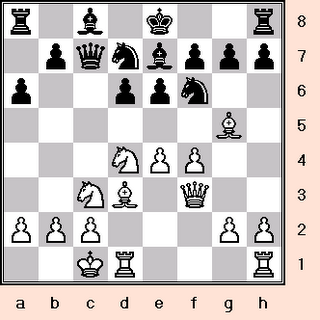
10 ... b5
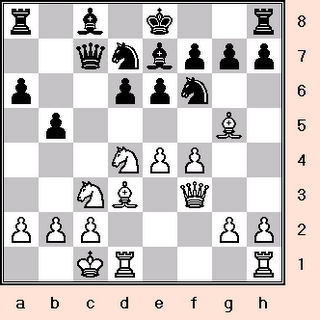
White enables Rh1-e1 in support of e4-e5 and Black
initiates queenside action. He also prepares for
11 ... Bb7.
Some alternatives for both sides are:
10 g4 h6 11 Bxf6 Bxf6 12 h4 Qb6 13 Nde2 Nc5
14 g5 Be7 15 Nd4 Bd7.
10 ... Nc5 11 Qg3 h6 12 Bh4 0-0 13 Rhe1 Nh5
14 Qg4 Bxh4 15 Qxh4 Nxf4 16 Qxf4 e5 17 Qh4
17 ... exd4 18 Nd5.
10 ... h6 11 Bh4 g5 12 fxg5 Ne5 13 Qe2 Nfg4
14 Nf3 hxg5 15 Bg3 Bd7 16 h3 Nxf3 17 hxg4
17 ... Rxh1 18 Rxh1 Nh4 19 e5 Bc6 20 Rf1
20 ... Bxg2 21 Rf2 Bc6 22 Qf1 d5 23 Rxf7
23 ... O-O-O.
10 ... h6 11 Bh4 g5 12 fxg5 Ne5 13 Qe2 Nfg4
14 Nf3 hxg5 15 Bg3 Bd7 16 h3 Nxf3 17 hxg4
17 ... Rxh1 18 Rxh1 Nh4 19 e5 Bc6 20 Rf1
20 ... Bxg2 21 Rf2 Bc6 22 Qf1 dxe5 23 Rxf7
23 ... Ng2 24 Rh7 Nf4 25 Bxf4 exf4 26 Rh8+
26 ... Bf8.
10 ... h6 11 Bh4 g5 12 fxg5 Ne5 13 Qe2 Nfg4
14 Nf3 hxg5 15 Bg3 Bd7 16 h3 Nxf3 17 hxg4
17 ... Rxh1 18 Rxh1 Nh4 19 e5 Bc6 20 Rf1
20 ... Bxg2 21 Rf2 Bc6 22 exd6 Bxd6
23 Bxd6 Qxd6 24 Qe3 Qe7 25 Ne4.
10 ... h6 11 Bh4 g5 12 fxg5 Ne5 13 Qe2 Nfg4
14 Nf3 hxg5 15 Bg3 Bd7 16 h3 Nxf3 17 hxg4
17 ... Rxh1 18 Rxh1 Nh4 19 e5 Bc6 20 Rf1
20 ... Bxg2 21 Rf2 dxe5 22 Rxg2 Nxg2
23 Qxg2 O-O-O.
10 ... h6 11 Bh4 g5 12 fxg5 Ne5 13 Qe2 Nfg4
14 Nf3 hxg5 15 Bg3 Bd7 16 h3 Nxf3 17 hxg4
17 ... Rxh1 18 Rxh1 Nh4 19 e5 Bc6 20 Rf1
20 ... Nxg2 21 exd6 Bxd6 22 Bxd6 Qxd6
23 Ne4 Bxe4 24 Bxe4 Nf4 25 Qf3 O-O-O
26 Bxb7+ Kc7.
10 ... h6 11 Bh4 g5 12 fxg5 Ne5 13 Qe2 Nfg4
14 Nf3 hxg5 15 Bg3 Bd7 16 h3 Nxf3 17 hxg4
17 ... Rxh1 18 Rxh1 Nh4 19 e5 Bc6 20 Rf1
20 ... Nxg2 21 Qf2 Nf4 22 Bxf4 gxf4
23 Qxf4 O-O-O.
10 ... h6 11 Bh4 g5 12 fxg5 Ne5 13 Qe2 Nfg4
14 Nf3 hxg5 15 Bg3 Bd7 16 h3 Nxf3 17 hxg4
17 ... Rxh1 18 Rxh1 Nh4 19 e5 Bc6 20 Rf1
20 ... Nxg2 21 Qf2 O-O-O 22 Qxf7 Nf4
23 Bxf4 gxf4 24 Qxe6+ Kb8.
10 ... h6 11 Bh4 g5 12 fxg5 Ne5 13 Qe2 Nfg4
14 Nf3 hxg5 15 Bg3 Bd7 16 h3 Nxf3 17 hxg4 Rxh1
18 Rxh1 Nh4 19 e5 Bc6 20 Rf1 Nxg2 21 Qf2 O-O-O
22 Qxf7 Kb8 23 Qxe6 Nf4 24 Bxf4 gxf4 25 exd6
25 ... Rxd6 26 Qe5.
10 ... h6 11 Bh4 g5 12 fxg5 Ne5 13 Qe2 Nfg4
14 Nf3 hxg5 15 Bg3 Nxf3 16 gxf3 Ne5 17 f4 gxf4
18 Bxf4 Bd7 19 Rdf1.
10 ... h6 11 Bh4 g5 12 fxg5 Ne5 13 Qe2 Nfg4
14 Nf3 hxg5 15 Bg3 Qc5.
10 ... h6 11 Bh4 g5 12 fxg5 Ne5 13 Qe2 Nfg4
14 Nf3 hxg5 15 Bg3 Qb6.
10 ... h6 11 Bh4 g5 12 fxg5 Ne5 13 Qe2 Nfg4
14 Nf3 hxg5 15 Bxg5 Bxg5+ 16 Nxg5 Qc5 17 Nh3
17 ... Bd7.
10 ... h6 11 Bh4 g5 12 fxg5 Ne5 13 Qe2 Nfg4
14 Nf3 Nxf3 15 gxf3 hxg5 16 Bg3 Ne5.
10 ... h6 11 Bh4 g5 12 fxg5 Ne5 13 Qe2 Nfg4
14 Nf3 Nxf3 15 gxf3 hxg5 16 fxg4 Rxh4 17 Rhf1.
11 Rhe1

11 ... Bb7
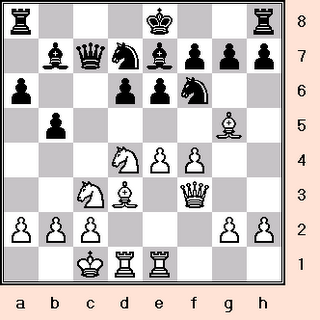
11 ... b4? 12 Nd5 exd5 13 Nf5 h6 ( 13 ... Bf8 14 e5)
14 Bh4 g5 15 e5 15 ... dxe5 16 fxe5 Nxe5 17 Rxe5
17 ... Bxf5 (17 ... Qxe5? 18 Bg3) 18 Qxf5.
12 Qg3

12 ... b4
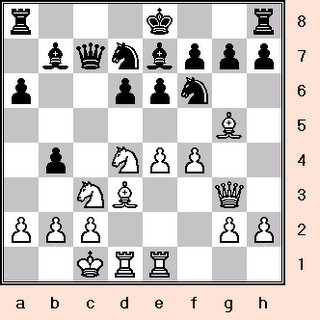
Just as White readies himself for e4-e5, Black attacks
the c3 knight.
12 ... 0-0-0? 13 Bxb5! axb5 14 Ndxb5 Qc5
(14 ... Qb6 15 e5 d5 16 f5!) 15 e5 dxe5 16 fxe5 Nd5
17 Bxe7 Qxe7 18 Nd6+ Kb8 19 Nxd5 Bxd5 20 Rxd5
20 ... exd5 21 Qb3, with mate to follow.
12 ... 0-0? 13 e5.
12 ... g6? 13 e5 dxe5 14 fxe5 Nh5 15 Qh4 Qd8
16 Ne4 Bxg5+ 17 Nxg5 Qe7 18 Qg4 Nc5 19 c3 Nxd3+
20 Rxd3.
13 Nd5
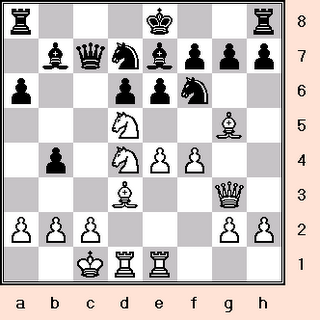
13 ... exd5

While this capture seems harmful to White,
it actually comes at the expense of Black's
centralized King.
13 ... Nxd5? 14 exd5 Bxd5 15 Nxe6 fxe6 16 Bxe7.
13 ... Bxd5? 14 exd5 Nxd5 15 Be4 Bxg5
16 Bxd5 0-0-0 17 Bxe6.
14 e5

Finally, the key maneuver is realized.
14 exd5? Kd8 15 Rxe7 Kxe7 16 Nf5+ Kd8 17 Bh4 Qc5
18 Qxg7 Kc7 19 Bxf6 Rhg8 20 Bd4 Rxg7 21 Bxc5 Nxc5
22 Nxg7 Rg8 23 Nf5 Rxg2, with equality.
14 ... dxe5
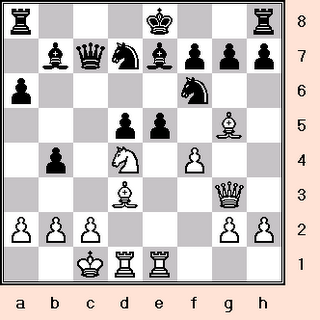
15 fxe5
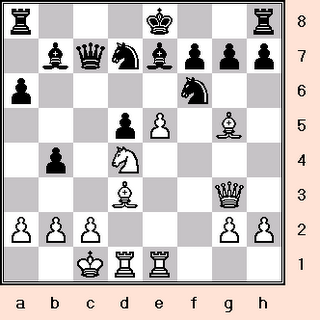
15 ... Nh5
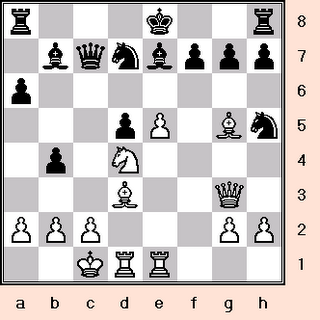
Attacking the Queen.
15 ... Ne4? 16 Bxe4 dxe4 17 Bxe7 Qxe5 18 Qxe5 Nxe5
19 Bxb4.
15 ... Ne4? 16 Bxe4 Bxg5+ 17 Qxg5 dxe4 18 Nf5 Qxe5
19 Nd6+ Kf8 20 Qxe5 Nxe5 21 Nxb7 Ng4 22 Nd6.
15 ... 0-0-0? 16 Nf5.
16 Qh4

Now, Black's e7 bishop and h5 knight are both
under fire.
16 e6 Nxg3 17 exf+ Kxf7 18 Rxe7 Kg8 19 hxg Qxg3
20 Ne6 Qe5 21 Rf1 Nf8! 22 Bf5 Bc8 23 Re8 Kf7 24 Re7+
24 ... Kg8 25 Re8 Kf7.
16 ... Bxg5+
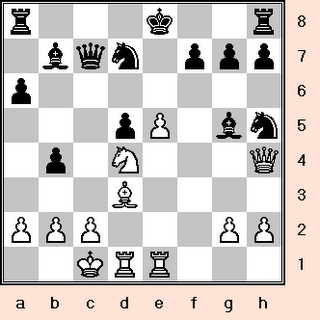
So, he uses a complimentary check to gain time
for protecting h5.
17 Qxg5
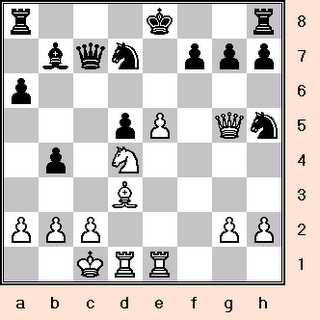
17 ... g6

18 e6
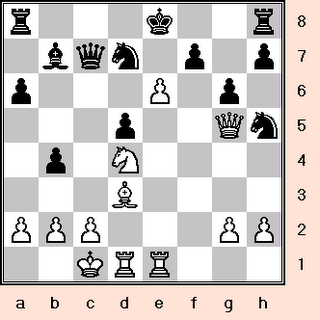
18 ... Nc5!

Black poises the knight for a forthcoming
e6 relocation. From e6, it can threaten the
Queen on g5 and also shield the dark squares
around its denuded King.
18 ... Ndf6 19 exf7+ Kxf7 20 Rf1 Rae8 21 g4 Qe5
22 Qxe5 Rxe5 23 gxh5 Rxh5 24 Rde1.
18 ... Qxf4+ 19 Qxf4 Nxf4 20 exd7+ Kxd7 21 Rf1
21 ... Nxd3 22 Rxd3 Rhf8 23 Rdf3 (23 Rf6 Rae8
24 Rb3) 23 ... Ke7 (23 ... f5 24 g4) 24 Re1+ (24 Re3+
24 ... Kd7 25 Rf6).
18 ... 0-0? 19 exd7 Rad8 20 g4 Qf4+ 21 Qxf4 Nxf4
22 Re7.
19 exf7+

19 ... Kxf7
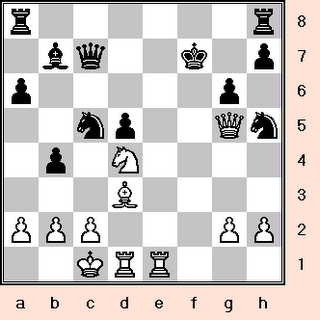
20 Rf1+
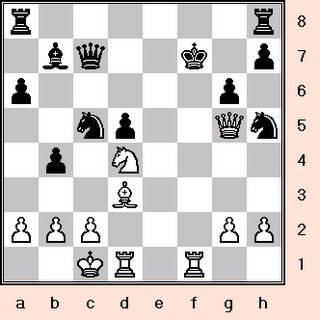
20 ... Kg8
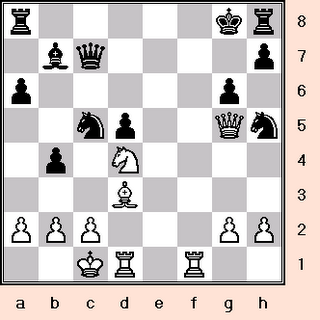
21 Nf5

21 ... Ne6
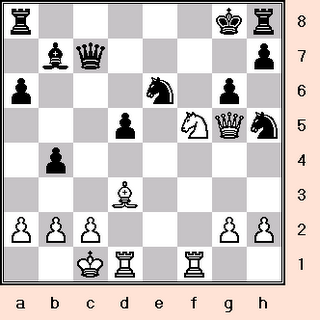
Taking advantage of the f5 knight's absence from d4
to occupy the more active e6 post. Henceforth, Black
should be able to hold his own.
By ChessCoach@care2.com
6 Bg5 e6 7 f4 Be7 8 Qf3 Qc7 9 O-O-O Line

Also available:
Chess: Understanding the Sicilian Najdorf Part II
http://chesscoach1950.blogspot.com/2006/07/chess-understanding-sicili_115316520058364198.html
Chess: Understanding the Sicilian Najdorf Part III
http://chesscoach1950.blogspot.com/2006/07/chess-understanding-sicilian-najdorf.html
Chess: Understanding the Sicilian Najdorf Part IV
http://chesscoach1950.blogspot.com/2006/07/chess-understanding-sicilian-najdorf_17.html
Chess: Understanding the Sicilian Najdorf Part V
http://chesscoach1950.blogspot.com/2006/07/chess-understanding-sicilian-defense_23.html
Chess: Understanding the Sicilian Najdorf Part VI
http://chesscoach1950.blogspot.com/2007/01/chess-understanding-sicilian-defense.html
Chess: Understanding the Sicilian Defense
(Accelerated Fianchetto)
http://chesscoach1950.blogspot.com/2006/07/chess-understanding-sicilian-defense.html
Chess: Understanding the Sicilian Defense
(Keres Attack) Part I
http://chesscoach1950.blogspot.com/2006/06/chess-understanding-sicilian.html
Chess: Understanding the Smith Morra Gambit
http://chesscoach1950.blogspot.com/2006/06/chess-understanding-smith-morra-gambit.html
Chess: Understanding the Sicilian Richter
http://chesscoach1950.blogspot.com/2006/06/chess-understanding-sicilian-richter.html
Chess: Understanding the Sicilian Defense
(Sveshnikov Variation)
http://chesscoach1950.blogspot.com/2006/06/chess-understanding-sicilian-defense.html
Chess: Understanding the Sicilian Defense
(Sozin Variation)
http://chesscoach1950.blogspot.com/2006/01/chess-understanding-sicilian-defense_30.html
Chess: Understanding the Sicilian Dragon
http://chesscoach1950.blogspot.com/2006/01/chess-understanding-sicilian-dragon.html
Chess: Understanding the Sicilian Defense
(Löwenthal Variation)
http://chesscoach1950.blogspot.com/2006/08/chess-understanding-sicilian-defense_23.html
Chess: Understanding the Sicilian Defense
http://chesscoach1950.blogspot.com/2006/08/chess-understanding-sicilian-defense_22.html
1 e4

Controlling the central square d5 plus near-central
square f5, and, opening up a diagonal for both the
Queen and f1 bishop.
1 ... c5

The d4 and b4 squares are now under Black's influence,
and his Queen also gets breathing space along the a5-d8
diagonal.
2 Nf3

White prepares for d4 so as to challenge Black's hold
on that key square.
2 ... d6

Shielding e5 from a prospective e4-e5 advance.
Please remember, the acquisition of e5 is a
critical theme for the defense. This move also
opens up a diagonal for the c8 bishop.
3 d4

3 ... cxd4

By trading his c-pawn for White's d-pawn,
Black guarantees pressure down the half
open c-file and chances to mold his
central pawn majority into a strong
center.
4 Nxd4

In return, White gains a developmental lead,
the half open d-file and an edge in space.
4 ... Nf6

The e4 pawn now needs protection, and so White
responds with:
5 Nc3

5 ... a6

Initiating the Najdorf Defense.
Black achieves two goals with this move:
(i) He deters White's pieces from intruding
on the b5 square.
(ii) He prepares for the ... b5 break, which,
in turn, initiates queenside action and
makes room on b7 for the c8 bishop.
6 Bg5

Threatening 7 Bxf6. The idea is to:
(i) Eliminate the knight's d5 influence in
order to attain a firmer grip on that focal
point.
(ii) Compromise Black's pawn structure
(7 Bxf6 gxf6/exf6).
6 ... e6

White's control of d5 and f5 is challenged and the
e7 square is vacated for the f8 bishop.
6 ... Nbd7 7 Bc4 Qa5 8 Qd2 e6 9 O-O-O b5 10 Bb3 Bb7
11 Rhe1 O-O-O 12 a3 Kb8 13 f4 Rc8 14 e5 dxe5 15 fxe5
15 ... b4 16 Na2 Ne4 17 axb4 Qxe5 18 Qf4 Qxf4+ 19 Bxf4+
19 ... e5 20 Nf5 exf4 21 Rxd7.
6 ... Qb6? 7 Bxf6 gxf6 8 Nd5 Qa5+ 9 Qd2 Qxd2+ 10 Kxd2,
and White looks better. The same is true after:
6 ... e5? 7 Nf5 Bxf5 8 exf5 Nbd7 9 Bc4 Rc8 10 Bb3 Be7
11 0-0 0-0 12 Bxf6 Nxf6 13 Qf3 b5 14 Rfd1.
6 ... e5? 7 Nf5 Bxf5 8 exf5 Nbd7 9 Bc4 Rc8 10 Bb3 Be7
11 0-0 0-0 12 Bxf6 Nxf6 13 Qf3 d5 14 Nxd5 e4
15 Nxf6+ Bxf6 16 Qxe4 Bxb2.
6 ... e5? 7 Nf5 Bxf5 8 exf5 Nbd7 9 Bc4 Rc8 10 Bb3 Be7
11 0-0 0-0 12 Bxf6 Nxf6 13 Qf3 d5 14 Nxd5 Nxd5
15 Rad1 e4 16 Qxe4 Nf6 17 Rxd8 Nxe4 18 Rxc8 Rxc8
19 Re1 Rd8 20 g3.
7 f4

Preparing for an eventual e4-e5 pawn push,
protecting the bishop on g5 and facilitating
the Queen's development to f3. Once there,
she can step sideways to g3 to aid e4-e5.
7 ... Be7

Breaking the pin on the f6 knight.
7 ... Qb6 inaugurates the Poisoned Pawn Variation:
8 Qd2 Qxb2 9 Rb1 Qa3 10 f5 Nc6 11 fxe6 fxe6 12 Nxc6
12 ... bxc6 13 e5 dxe5 14 Bxf6 gxf6 15 Be2.
7 ... Qb6 8 Nb3 Be7 9 Qf3 Nbd7 10 O-O-O Qc7 11 Bd3 b5
12 a3 Bb7 13 Rhe1 O-O-O 14 Qe2 h6 15 Bh4 g5 16 Bg3 gxf4
17 Bxf4 Ne5 18 Kb1.
7 ... b5 8 e5 dxe5 9 fxe5 Qc7 10 exf6 Qe5+ 11 Be2 Qxg5
12 Qd3 Qxf6 13 O-O-O Be7 14 Rhf1 Qh6+ 15 Kb1 O-O 16 Qg3
16 ... Qg5.
7 ... b5 8 e5 dxe5 9 fxe5 Qc7 10 exf6 Qe5+ 11 Be2 Qxg5
12 Qd3 Qxf6 13 Rf1 Qe5 14 O-O-O Ra7 15 Ndxb5 Qg5+
16 Rd2 Rd7.
8 Qf3

8 ... Qc7

From c7, the Queen dissuades White from
advancing 9 e4-e5 because of 9 ... dxe5 10 fxe5
10 ... Qxe5+. Additionally, she gets to mind
the half open c-file. Please observe how the
Queen cannot be harassed by Ndb5 because
of 5 ... a6.
Another popular option is 8 ... h6 9 Bh4 Qc7 10 0-0-0 Nbd7
11 Bd3 g5 12 fxg5 Ne5 13 Qe2 Nfg4 14 Nf3 hxg5 15 Bg3 Nxf3
16 gxf3 Ne5 17 Qf2 Bd7 18 h4 gxh4 19 Bxh4 Qc5 20 Qxc5 dxc5
21 Bxe7 Nxd3+ 22 cxd3 Kxe7.
9 0-0-0

Assigning the King to safety and developing the a1 rook
to the half open d-file.
9 ... Nbd7

Development towards the ever so important e5 square.
Also, the knight gains access to c5.
9 ... Nc6 10 Nxc6 bxc6 11 e5 dxe5 12 fxe5 Nd5
13 Bxe7 Nxe7 14 Ne4 0-0 15 Qc3 Nd5 16 Qd4 Rb8
17 c4 c5 18 Nxc5 Nb4.
9 ... h6 10 Bh4 Nxe4 11 Qxe4 Bxh4 12 Nf5 Be7
13 Nxg7+ Kf8 14 Nh5 f5 15 Qe3.
10 Bd3

10 ... b5

White enables Rh1-e1 in support of e4-e5 and Black
initiates queenside action. He also prepares for
11 ... Bb7.
Some alternatives for both sides are:
10 g4 h6 11 Bxf6 Bxf6 12 h4 Qb6 13 Nde2 Nc5
14 g5 Be7 15 Nd4 Bd7.
10 ... Nc5 11 Qg3 h6 12 Bh4 0-0 13 Rhe1 Nh5
14 Qg4 Bxh4 15 Qxh4 Nxf4 16 Qxf4 e5 17 Qh4
17 ... exd4 18 Nd5.
10 ... h6 11 Bh4 g5 12 fxg5 Ne5 13 Qe2 Nfg4
14 Nf3 hxg5 15 Bg3 Bd7 16 h3 Nxf3 17 hxg4
17 ... Rxh1 18 Rxh1 Nh4 19 e5 Bc6 20 Rf1
20 ... Bxg2 21 Rf2 Bc6 22 Qf1 d5 23 Rxf7
23 ... O-O-O.
10 ... h6 11 Bh4 g5 12 fxg5 Ne5 13 Qe2 Nfg4
14 Nf3 hxg5 15 Bg3 Bd7 16 h3 Nxf3 17 hxg4
17 ... Rxh1 18 Rxh1 Nh4 19 e5 Bc6 20 Rf1
20 ... Bxg2 21 Rf2 Bc6 22 Qf1 dxe5 23 Rxf7
23 ... Ng2 24 Rh7 Nf4 25 Bxf4 exf4 26 Rh8+
26 ... Bf8.
10 ... h6 11 Bh4 g5 12 fxg5 Ne5 13 Qe2 Nfg4
14 Nf3 hxg5 15 Bg3 Bd7 16 h3 Nxf3 17 hxg4
17 ... Rxh1 18 Rxh1 Nh4 19 e5 Bc6 20 Rf1
20 ... Bxg2 21 Rf2 Bc6 22 exd6 Bxd6
23 Bxd6 Qxd6 24 Qe3 Qe7 25 Ne4.
10 ... h6 11 Bh4 g5 12 fxg5 Ne5 13 Qe2 Nfg4
14 Nf3 hxg5 15 Bg3 Bd7 16 h3 Nxf3 17 hxg4
17 ... Rxh1 18 Rxh1 Nh4 19 e5 Bc6 20 Rf1
20 ... Bxg2 21 Rf2 dxe5 22 Rxg2 Nxg2
23 Qxg2 O-O-O.
10 ... h6 11 Bh4 g5 12 fxg5 Ne5 13 Qe2 Nfg4
14 Nf3 hxg5 15 Bg3 Bd7 16 h3 Nxf3 17 hxg4
17 ... Rxh1 18 Rxh1 Nh4 19 e5 Bc6 20 Rf1
20 ... Nxg2 21 exd6 Bxd6 22 Bxd6 Qxd6
23 Ne4 Bxe4 24 Bxe4 Nf4 25 Qf3 O-O-O
26 Bxb7+ Kc7.
10 ... h6 11 Bh4 g5 12 fxg5 Ne5 13 Qe2 Nfg4
14 Nf3 hxg5 15 Bg3 Bd7 16 h3 Nxf3 17 hxg4
17 ... Rxh1 18 Rxh1 Nh4 19 e5 Bc6 20 Rf1
20 ... Nxg2 21 Qf2 Nf4 22 Bxf4 gxf4
23 Qxf4 O-O-O.
10 ... h6 11 Bh4 g5 12 fxg5 Ne5 13 Qe2 Nfg4
14 Nf3 hxg5 15 Bg3 Bd7 16 h3 Nxf3 17 hxg4
17 ... Rxh1 18 Rxh1 Nh4 19 e5 Bc6 20 Rf1
20 ... Nxg2 21 Qf2 O-O-O 22 Qxf7 Nf4
23 Bxf4 gxf4 24 Qxe6+ Kb8.
10 ... h6 11 Bh4 g5 12 fxg5 Ne5 13 Qe2 Nfg4
14 Nf3 hxg5 15 Bg3 Bd7 16 h3 Nxf3 17 hxg4 Rxh1
18 Rxh1 Nh4 19 e5 Bc6 20 Rf1 Nxg2 21 Qf2 O-O-O
22 Qxf7 Kb8 23 Qxe6 Nf4 24 Bxf4 gxf4 25 exd6
25 ... Rxd6 26 Qe5.
10 ... h6 11 Bh4 g5 12 fxg5 Ne5 13 Qe2 Nfg4
14 Nf3 hxg5 15 Bg3 Nxf3 16 gxf3 Ne5 17 f4 gxf4
18 Bxf4 Bd7 19 Rdf1.
10 ... h6 11 Bh4 g5 12 fxg5 Ne5 13 Qe2 Nfg4
14 Nf3 hxg5 15 Bg3 Qc5.
10 ... h6 11 Bh4 g5 12 fxg5 Ne5 13 Qe2 Nfg4
14 Nf3 hxg5 15 Bg3 Qb6.
10 ... h6 11 Bh4 g5 12 fxg5 Ne5 13 Qe2 Nfg4
14 Nf3 hxg5 15 Bxg5 Bxg5+ 16 Nxg5 Qc5 17 Nh3
17 ... Bd7.
10 ... h6 11 Bh4 g5 12 fxg5 Ne5 13 Qe2 Nfg4
14 Nf3 Nxf3 15 gxf3 hxg5 16 Bg3 Ne5.
10 ... h6 11 Bh4 g5 12 fxg5 Ne5 13 Qe2 Nfg4
14 Nf3 Nxf3 15 gxf3 hxg5 16 fxg4 Rxh4 17 Rhf1.
11 Rhe1

11 ... Bb7

11 ... b4? 12 Nd5 exd5 13 Nf5 h6 ( 13 ... Bf8 14 e5)
14 Bh4 g5 15 e5 15 ... dxe5 16 fxe5 Nxe5 17 Rxe5
17 ... Bxf5 (17 ... Qxe5? 18 Bg3) 18 Qxf5.
12 Qg3

12 ... b4

Just as White readies himself for e4-e5, Black attacks
the c3 knight.
12 ... 0-0-0? 13 Bxb5! axb5 14 Ndxb5 Qc5
(14 ... Qb6 15 e5 d5 16 f5!) 15 e5 dxe5 16 fxe5 Nd5
17 Bxe7 Qxe7 18 Nd6+ Kb8 19 Nxd5 Bxd5 20 Rxd5
20 ... exd5 21 Qb3, with mate to follow.
12 ... 0-0? 13 e5.
12 ... g6? 13 e5 dxe5 14 fxe5 Nh5 15 Qh4 Qd8
16 Ne4 Bxg5+ 17 Nxg5 Qe7 18 Qg4 Nc5 19 c3 Nxd3+
20 Rxd3.
13 Nd5

13 ... exd5

While this capture seems harmful to White,
it actually comes at the expense of Black's
centralized King.
13 ... Nxd5? 14 exd5 Bxd5 15 Nxe6 fxe6 16 Bxe7.
13 ... Bxd5? 14 exd5 Nxd5 15 Be4 Bxg5
16 Bxd5 0-0-0 17 Bxe6.
14 e5

Finally, the key maneuver is realized.
14 exd5? Kd8 15 Rxe7 Kxe7 16 Nf5+ Kd8 17 Bh4 Qc5
18 Qxg7 Kc7 19 Bxf6 Rhg8 20 Bd4 Rxg7 21 Bxc5 Nxc5
22 Nxg7 Rg8 23 Nf5 Rxg2, with equality.
14 ... dxe5

15 fxe5

15 ... Nh5

Attacking the Queen.
15 ... Ne4? 16 Bxe4 dxe4 17 Bxe7 Qxe5 18 Qxe5 Nxe5
19 Bxb4.
15 ... Ne4? 16 Bxe4 Bxg5+ 17 Qxg5 dxe4 18 Nf5 Qxe5
19 Nd6+ Kf8 20 Qxe5 Nxe5 21 Nxb7 Ng4 22 Nd6.
15 ... 0-0-0? 16 Nf5.
16 Qh4

Now, Black's e7 bishop and h5 knight are both
under fire.
16 e6 Nxg3 17 exf+ Kxf7 18 Rxe7 Kg8 19 hxg Qxg3
20 Ne6 Qe5 21 Rf1 Nf8! 22 Bf5 Bc8 23 Re8 Kf7 24 Re7+
24 ... Kg8 25 Re8 Kf7.
16 ... Bxg5+

So, he uses a complimentary check to gain time
for protecting h5.
17 Qxg5

17 ... g6

18 e6

18 ... Nc5!

Black poises the knight for a forthcoming
e6 relocation. From e6, it can threaten the
Queen on g5 and also shield the dark squares
around its denuded King.
18 ... Ndf6 19 exf7+ Kxf7 20 Rf1 Rae8 21 g4 Qe5
22 Qxe5 Rxe5 23 gxh5 Rxh5 24 Rde1.
18 ... Qxf4+ 19 Qxf4 Nxf4 20 exd7+ Kxd7 21 Rf1
21 ... Nxd3 22 Rxd3 Rhf8 23 Rdf3 (23 Rf6 Rae8
24 Rb3) 23 ... Ke7 (23 ... f5 24 g4) 24 Re1+ (24 Re3+
24 ... Kd7 25 Rf6).
18 ... 0-0? 19 exd7 Rad8 20 g4 Qf4+ 21 Qxf4 Nxf4
22 Re7.
19 exf7+

19 ... Kxf7

20 Rf1+

20 ... Kg8

21 Nf5

21 ... Ne6

Taking advantage of the f5 knight's absence from d4
to occupy the more active e6 post. Henceforth, Black
should be able to hold his own.
By ChessCoach@care2.com

0 Comments:
Post a Comment
<< Home